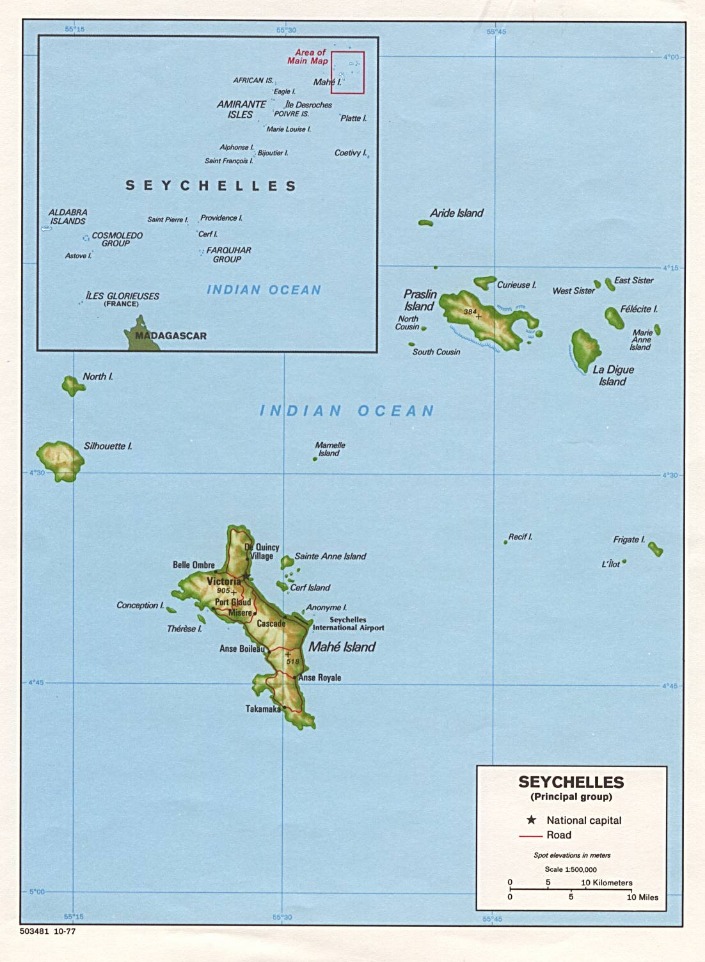Overview of Population Size and Density
The demographics of Seychelles provide insight into the population size and density of this island nation. Understanding these key aspects helps to comprehend how the population is distributed across the archipelago and what factors influence its growth and living conditions. Population size and density are crucial indicators for planning resources, infrastructure, and social services in Seychelles.
Total Population
The demographics of Seychelles are characterized by a relatively small and densely populated nation located in the Indian Ocean. The total population of Seychelles is approximately 98,000 people, making it one of the smaller countries in the world by population size. Despite its modest population, the country exhibits a high population density, with around 210 residents per square kilometer. This density reflects the concentration of people on the main islands, particularly Mahé, which hosts the capital city, Victoria. The population size has seen gradual growth over recent decades due to internal and external migration trends, contributing to the dynamic demographic landscape of Seychelles.
Population Density
The demographics of Seychelles are characterized by relatively small population size and high population density, given its geographical size. Population size refers to the total number of people residing in the country, which has been slowly increasing over the years. Population density measures how many individuals live per square kilometer, providing insight into how crowded or sparsely populated areas are within Seychelles. Despite its small landmass, Seychelles exhibits a high population density due to its concentrated settlements and urban centers. This density influences various aspects of daily life, including infrastructure, resource allocation, and environmental management. Understanding population density helps in planning development and ensuring sustainable growth for the nation.
Age Distribution
The age distribution of a population provides crucial insights into its demographic structure and future trends. In the context of Seychelles, understanding the age composition helps to identify the challenges and opportunities related to workforce development, healthcare, and social services. Analyzing how different age groups are represented in the population reveals important patterns that influence the country’s economic and social planning efforts.
Population by Age Group
The demographics of Seychelles reveal a diverse age distribution within its population, reflecting a balanced structure across various age groups. The population by age group shows a significant concentration of younger individuals, including children and teenagers, which indicates ongoing natural growth. Adults in the working age range comprise a substantial portion of the population, supporting the country’s economic activities and development. The older age groups, while smaller in comparison, are increasingly prevalent due to improved healthcare and longevity. Overall, Seychelles’ age distribution demonstrates a dynamic demographic landscape that influences social policies and future planning for the nation.
Median Age
The demographics of Seychelles reveal interesting insights into the age distribution of its population. The median age in Seychelles is approximately 33 years, indicating a relatively young population compared to many other countries. The age distribution shows a balanced proportion of young people and adults, with a notable percentage of the population falling within the working-age group. This demographic profile suggests a dynamic society with potential for growth and development. The median age has shown a gradual increase over the years, reflecting improving life expectancy and changing fertility rates. Understanding the age distribution is essential for planning social services, healthcare, and economic policies in Seychelles.
Gender Composition
Gender composition refers to the distribution of males and females within a population, providing insights into societal structure and demographic trends. In the context of Seychelles, understanding gender demographics offers valuable information about the social dynamics, gender roles, and population balance in this island nation. Analyzing these patterns helps in shaping policies, addressing gender-specific issues, and promoting equality across different sectors.
Male to Female Ratio
The gender composition of Seychelles showcases a near-balanced distribution between males and females. The male to female ratio in the country is approximately 0.99, indicating a slightly higher number of females compared to males. This demographic characteristic is typical for Seychelles, reflecting its relatively equal gender representation across the population. Understanding this ratio is essential for analyzing social dynamics, workforce participation, and planning for future development needs within the nation.
Gender Distribution Across Age Groups
The gender composition and distribution across different age groups in Seychelles provide insights into the population structure and societal dynamics of the country. Understanding these patterns helps in planning for social services, healthcare, and economic development.
- The overall gender ratio in Seychelles is relatively balanced, with a slight female majority, which is common in many populations due to higher female life expectancy.
- In the younger age groups, the gender distribution tends to be more balanced or slightly male-biased, reflecting birth ratios and early life demographics.
- Among older age groups, especially those above 60, there is usually a higher proportion of females, attributed to higher female longevity.
- Gender distribution varies notably across age groups, with males being more prevalent in youth, while females tend to dominate in older demographics.
- This age-related gender pattern impacts social and healthcare policies, emphasizing the need for gender-specific planning in Seychelles.
Ethnic and Cultural Composition
The demographics of Seychelles are characterized by a rich tapestry of ethnic and cultural influences that reflect its diverse history. This small island nation in the Indian Ocean is home to a variety of ethnic groups, each contributing unique traditions, languages, and customs. Understanding the ethnic and cultural composition of Seychelles provides insight into the nation’s vibrant society and multicultural identity.
Main Ethnic Groups
The demographics of Seychelles are characterized by a diverse ethnic and cultural composition, reflecting its history as a melting pot of different peoples. The main ethnic groups in Seychelles include the Creole population, which forms the largest group and is primarily of mixed African, European, and Asian descent. There are also significant communities of French, Indian, Chinese, and Arab origins, each contributing to the rich cultural mosaic of the islands. This diverse ethnic makeup has fostered a unique cultural identity that is celebrated through language, customs, cuisine, and festivals across the nation. Overall, Seychelles’ demographic landscape showcases a harmonious blend of various ethnicities that have shaped its social and cultural fabric.
Cultural Diversity and Influences
The demographics of Seychelles reflect a rich tapestry of ethnic and cultural influences that have shaped the nation’s social fabric. The country is characterized by a high degree of cultural diversity, resulting from historical interactions among African, European, Asian, and Middle Eastern populations. This blend is evident in the languages spoken, religious practices, festivals, and daily customs of Seychellois people. English, along with Creole and French, serves as official languages, symbolizing the multicultural influences that have converged over centuries. The diverse ethnic composition contributes to a vibrant cultural landscape, fostering a sense of unity amidst differences and enriching Seychelles’ national identity. This diversity is a key aspect of the nation’s demographic profile and continues to influence its social and cultural development.
Urban and Rural Distribution
Urban and rural distribution refers to the way populations are spread across different areas within a country. Understanding this distribution helps to analyze settlement patterns, access to resources, and economic activities. In the context of Seychelles, a nation characterized by both bustling urban centers and serene rural regions, examining these demographics reveals important insights into its social and economic landscape.
Urban Population Centers
The demographics of Seychelles exhibit a diverse distribution of populations between urban and rural areas, with a noticeable concentration of inhabitants in urban population centers. Urban areas in Seychelles, particularly Victoria, the capital city, serve as the main hubs for administrative, economic, and social activities, attracting a large portion of the population. These urban centers offer better access to services, employment, education, and healthcare, leading to a higher density of residents compared to rural regions. In contrast, rural areas tend to have smaller, more dispersed communities with less infrastructure development, contributing to a less dense population. Understanding the distribution of populations between urban and rural zones is essential for planning resources, infrastructure development, and social services to support the country’s growth and development.
Rural Areas and Communities
The demographic distribution of Seychelles highlights a distinct contrast between urban and rural areas, influencing social, economic, and cultural aspects of the country. Urban regions, primarily centered around Victoria, the capital city, are characterized by higher population densities, better access to services, infrastructure, and employment opportunities. In contrast, rural areas consist of smaller communities spread across islands and remote regions, often with limited facilities and economic activities centered around agriculture, fishing, and local crafts. Rural communities typically maintain traditional lifestyles and are vital for preserve cultural heritage and natural resources. Understanding this distribution is essential for planning development projects, resource allocation, and ensuring balanced growth across the nation.
Language and Religion
Language and religion are fundamental aspects of the cultural identity in Seychelles, shaping the daily lives and community bonds of its people. The island nation is characterized by a rich linguistic diversity and a variety of religious beliefs that reflect its historical connections and multicultural heritage. Understanding these elements provides insights into the social fabric and demographic landscape of Seychelles.
Official and Common Languages
The demographics of Seychelles are shaped by its diverse cultural heritage, which is reflected in the country’s language and religious practices. Language and religion play a significant role in the social fabric of this island nation, influencing daily life and community interactions.
Official and common languages in Seychelles include:
- English
- French
- Creole (Seychellois Creole)
Among these, Seychellois Creole is the most widely spoken language in informal settings, serving as a unifying cultural identifier. English is used in government, business, and education, ensuring effective communication in official contexts. French also maintains a strong presence due to historical ties and is commonly spoken among certain communities and for cultural reasons.

Religious Affiliations
The demographics of Seychelles reflect a diverse and vibrant society shaped by various cultural and religious influences. Language and religion play significant roles in defining the social fabric of this island nation.
In Seychelles, the official languages are Seychellois Creole, English, and French. Creole, derived from French, serves as the lingua franca and is widely spoken among the population. English is used mainly in government and education, while French remains influential due to historical ties.
Religiously, Seychelles is predominantly Christian, with the majority of the population adhering to Roman Catholicism. Other Christian denominations, including Protestant and Anglican communities, are also present. There are small Muslim and Hindu communities that contribute to the country’s religious diversity.
- Roman Catholicism is the largest religious affiliation, representing a significant majority of the population.
- Protestant and Anglican churches are the main non-Catholic Christian groups.
- Islamic and Hindu communities are minority groups yet integral to the multicultural landscape.
Migration and Population Movement
Migration and population movement are vital factors that shape the demographics of any country. They influence the social, economic, and cultural landscape by determining population growth, diversity, and distribution. In the context of Seychelles, understanding these movements provides insight into the island nation’s demographic trends and how they impact development and society as a whole.
Immigration Trends
The demographics of Seychelles are significantly shaped by migration and population movement trends that have evolved over the years. As an island nation, Seychelles has experienced various waves of immigration, primarily driven by economic opportunities, employment prospects, and the search for better living standards. Historically, the population includes a diverse mix of ethnic groups, including African, European, and Asian origins, reflecting a rich cultural heritage resulting from migration patterns. In recent decades, immigration has contributed to the growth of the population and the diversification of communities, with an influx of expatriates and foreign workers, particularly in sectors like tourism and fisheries. These trends have influenced demographic factors such as age distribution, language diversity, and urbanization, shaping the socio-economic landscape of Seychelles today.
Emigration Patterns
The demographics of Seychelles are significantly influenced by migration and population movement, particularly through patterns of emigration. Over the years, many Seychellois have chosen to migrate to other countries in search of better economic opportunities, education, and quality of life. This emigration trend has led to a reduction in the native population but has also resulted in a vibrant diaspora that maintains strong cultural and economic ties to Seychelles. Factors such as limited local employment prospects, political stability, and global connectivity contribute to these migration patterns. Additionally, the influx of expatriates and seasonal workers from neighboring countries impacts the demographic composition, enriching the diversity of the island nation while simultaneously shaping its population dynamics.
Socioeconomic Demographics
The socioeconomic demographics of Seychelles offer a fascinating glimpse into the country’s diverse population and economic landscape. Understanding these demographics provides insight into the social structure, income distribution, education levels, and employment patterns that shape life on this island nation. Analyzing these factors helps to highlight the challenges and opportunities faced by Seychelles as it continues to develop and navigate its unique demographic profile.
Educational Attainment
Seychelles exhibits a diverse socioeconomic demographic profile characterized by a relatively small but economically active population. The nation’s income levels vary, with a significant portion of residents engaged in tourism, fisheries, and agriculture, which are vital to its economy. The urban centers, particularly Victoria, serve as economic hubs, contributing to a concentration of wealth and resources in these areas. Despite its small size, Seychelles demonstrates a relatively high standard of living compared to many other countries in the region.
Regarding educational attainment, Seychelles boasts one of the highest literacy rates in Africa, with widespread access to primary and secondary education. Efforts to improve educational facilities and literacy have resulted in a skilled workforce, which supports the country’s development initiatives. Higher education institutions are available within the country, and many students pursue further studies abroad. Overall, the educational landscape in Seychelles reflects a strong commitment to improving human capital and fostering socio-economic development.
Income and Employment Statistics
The socioeconomic demographics of Seychelles reveal a diverse population characterized by a mix of cultural backgrounds, economic activities, and income levels. The country has a relatively small population with a stable growth rate, allowing for targeted development policies. In terms of income, Seychelles has a mixed economy heavily reliant on tourism, fisheries, and agriculture, which influences the standard of living across different regions. The average household income varies significantly between urban centers and rural areas, with urban populations generally enjoying higher incomes due to better employment opportunities.
Employment statistics indicate that the majority of the Seychellois workforce is engaged in the service sector, particularly tourism and hospitality. Fishing and agriculture also provide substantial employment, especially in rural communities. Unemployment rates have fluctuated over recent years but tend to be lower than regional averages, reflecting the country’s relatively strong economic fundamentals. Additionally, income inequality remains a concern, with efforts ongoing to improve access to education and job opportunities for disadvantaged groups to foster more equitable socioeconomic development.





0 Comments